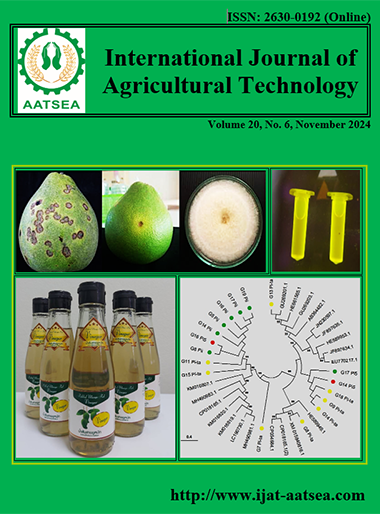Effect of organic seed coating agents on the physical characteristics and seed quality of tomato (Lycopersicon esculentum Mill.)
Main Article Content
Abstract
Cultivating plants in organic agriculture requires the same level of care in seed coating technology as in conventional farming. The physical characteristics of six polymers indicated a slight alkaline nature. Other polymers showed similar viscosities and increased in viscosity as the concentration level increased, with xanthan gum exhibiting the highest viscosity at the same concentration level. Gelatin, carrageenan, sodium alginate, and gum arabic dissolved well when in film form. Coating seeds with 0.2% w/v sodium alginate showed a significantly higher radicle emergence percentage, radicle emergence speed, germination rate, germination speed, shoot length, and root length compared to non-coated seeds. Therefore, it is recommended to use 0.2% w/v sodium alginate for coating organic tomato seeds
Article Details

This work is licensed under a Creative Commons Attribution-NonCommercial-NoDerivatives 4.0 International License.
References
Agricultural Research Development Agency. (2000). Standards for organic crop production in Thailand. Agricultural Cooperative Community of Thailand Ltd., Bangkok, Thailand.
AOSA. (1983). Seed vigor testing handbook. AOSA. New York, Ithaca. (Contribution to the Handbook on Seed Testing, 32.
Arancon, N. Q., Pant, A., Radovich, T., Hue, N. V., Potter, J. K. and Converse, C. E. (2012). Seed germination and seedling growth of tomato and lettuce as affected by vermicompost water extracts (teas). HortScience, 47:1722-1728.
Bonina, B. and Cantliffe, D. (2004). Seed production and seed sources of organic vegetable. Horticultural Sciences. Florida: Department Cooperative Extension Service, Institute of Food and Agricultural Sciences, University of Florida, Gainesville.
Deaker, R., Roughley, R. J. and Kennedy, I. R. (2004). Legume seed inoculation technology—a review. Soil biology and biochemistry, 36:1275-1288.
Fernando, I. P. S., Lee, W., Han, E. J. and Ahn, G. (2010). Alginate-based nanomaterials: Fabrication techniques, properties, and applications. Chemical Engineering Journal, 391:123823.
Fertah, M., Belfkira, A., Taourirte, M. and Brouillette, F. (2017). Extraction and characterization of sodium alginate from Moroccan Laminaria digitata brown seaweed. Arabian Journal of Chemistry, 10:S3707-S3714.
Frent, O. D., Vicas, L. G., Duteanu, N., Morgovan, C. M., Jurca, T., Pallag, A., Muresan, M. E., Filip, S. M., Lucaciu, R. L. and Marian, E. (2022). Sodium alginate—natural microencapsulation material of polymeric microparticles. International Journal of Molecular Sciences, 23:12108.
Goh, C. H., Heng, P. W. S. and Chan, L. W. (2012). Alginates as a useful natural polymer for microencapsulation and therapeutic applications. Carbohydrate Polymers, 88:1-12.
ISTA (2019). International rules for seed testing, Edition International Seed Testing Association, Bassersdorf.
ISTA. (2022). International rules for seed testing, Edition International Seed Testing Association, Bassersdorf.
Kangsopa, J. and Jeephet, P. (2021). Effect of osmopriming and coating seed with captan and metalaxyl on the germination and seedling growth of field corn. International Journal of Agricultural Technology, 17:909-920.
Kangsopa, J. and Atnaseo, C. (2022). Seed coating application of endophytic and rhizosphere bacteria for germination enhancement and seedling growth promotion in soybeans. International Journal of Agricultural Technology, 18:215-230.
Korkasetwit, S. (2008). Effects of coating substances on quality and longevity of sweet corn seed. (Master Thesis). Graduate School, Khon Kaen University, Khon Kaen, Thailand.
Raj, S. N., Lavanya, S. N., Sudisha, J. and Shetty, H. S. (2011). Applications of biopolymers in agriculture with special reference to role of plant derived biopolymers in crop protection. In: Kalia, S. and Avérous, L. Eds. Biopolymers: Biomédical and Environmental Applications. Scrivener Publishing LLC., Salem, Massachusetts. pp.459-481.
Shah, F. and Wu, W. (2019). Soil and crop management strategies to ensure higher crop productivity within sustainable environments. Sustainability, 11:1485.
Siri, B. (2015). Seed conditioning and seed enhancements. Klungnanawitthaya Priting. Khon Kaen, Thailand.


